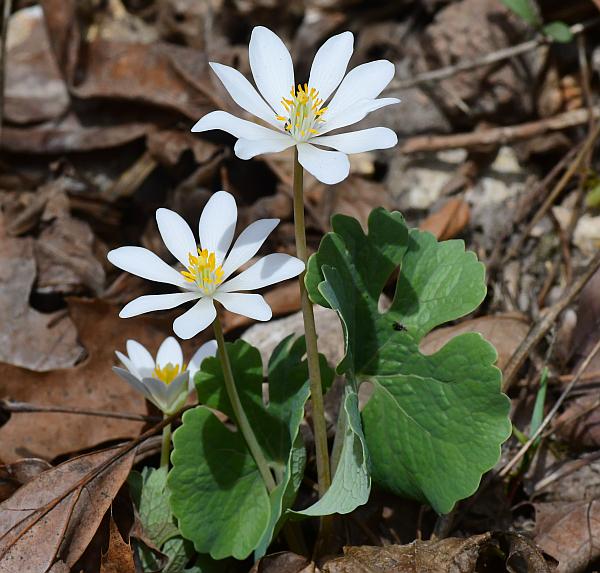Sanguinaria canadensis L.
Bloodroot

Native
CC = 5
CW = 5
MOC = 60
© SRTurner
Sanguinaria canadensis L.Bloodroot | |
 |
Native CC = 5 CW = 5 MOC = 60 |
© SRTurner |
|
Family - Papaveraceae Habit - Perennial forb, with thick, sometimes branched rhizomes; sap reddish orange to red. Stems - Aerial stems absent.
Leaves - Usually 1 per year from the apical portion of the rhizome, the petioles 5-15 cm long, erect. Leaf blades 6-17 cm long, 8-20 cm wide, initially curved around the scape, glabrous, more or less circular to broadly kidney-shaped in outline, variously shallowly 3-lobed at the tip or with 3-7 palmate lobes, cordate to deeply cordate at the base, the lobes rounded to bluntly and broadly pointed, the margins otherwise shallowly scalloped or wavy, the upper suface green, the undersurface pale, somewhat glaucous.
Inflorescence - Flowers solitary, the stalk 5-15 cm long at flowering, erect, lacking subtending bracts, glabrous, the receptacle slightly expanded at the tip but not forming a cup or disc. Flowers - Sepals 2, free, shed individually as the flower opens, 8-12 mm long, elliptic-ovate, bluntly pointed at the tip. Petals 7-12, typically 8 (4 being slightly larger then the others), 12-30 mm long, 5-12 mm wide, white, oblanceolate to narrowly elliptic, glabrous, entire. Stamens numerous. Filaments 5-10 mm long. Ovary tapered to a persistent style 1-3 mm long, the stigma more or less capitate, with 2, shallow, downward-angled lobes. Style very short (1mm long). Stigma 2-lobed.
Fruits - Capsules 30-55 mm long, erect, narrowly ellipsoid, glabrous, somewhat glaucous, dehiscing longitudinally from the base by 2 valves. Seeds 10-15 per capsule, 3.0-3.8 mm long, ovoid to nearly globose, with a crestlike aril along 1 side, the surface otherwise smooth or faintly pebbled, reddish brown to nearly black, shiny.
Flowering - March - April. Habitat - Bottomland and mesic forests, streambanks, bluffs bases, ravines. Origin - Native to the U.S. Lookalikes - None. Other info. - This is one the most recognizable and widely appreciated members of Missouri's springtime ephemeral flora, common in the Ozark and Ozark Border regions but rare or absent in many northwestern counties. Its range includes the eastern half of the continental U.S. and parts of Canada, but does not extend much to the west of Missouri. The plant is easily identified by general appearance. Even when not flowering, its leaves are distinctive and unique in shape among Missouri's flora. The striking flowers are short lived, and the plants are most often seen in fruiting or vegetative condition. Photographs taken in Vale, NC., 3-15-03, in Umstead State Park, NC., 3-23-03, and at Eagle Bluffs Conservation Area, Boone County, MO., 3-20-04 (DETenaglia); also at Shaw Nature Reserve, Franklin County, MO, 3-21-2009, Rockwoods Reservation, St. Louis County, MO, 4-8-2010, Weldon Spring Conservation Area, St. Charles County, MO, 3-22-2016 and 3-30-2020, Glassberg Conservation Area, Jefferson County, MO, 4-5-2018, and Young Conservation Area, Jefferson County, MO, 5-17-2019 (SRTurner). |